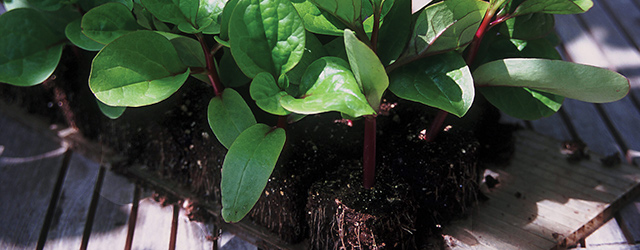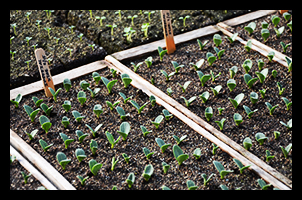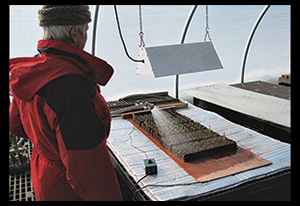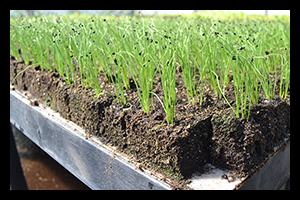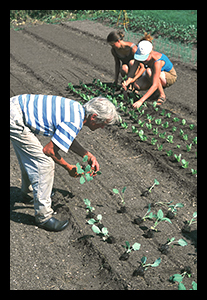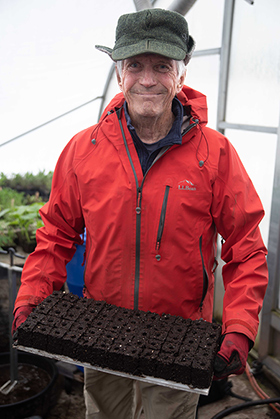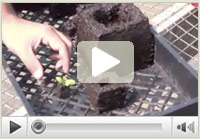- Seed-Starting Date Calculator: When to Start Seeds Indoors | Johnny's Selected Seeds
- Seed-starting Methods at Johnny's Greenhouses | 3 Systems for Starting Professional-Quality Seedlings Indoors
- Guidelines for Starting Seeds Indoors | Tips & Troubleshooting Advice for Starting Healthy Seedlings
- Transplanted Vegetable Crops | Plant Quantity & Average Yield Chart + Feet of Row per Acre
- Transplanted Vegetable Crop Yield Chart | Number of Plants Yielded per Seed Quantity & Average Harvest Yield
- Johnny's 512 Mix | Instructions for Using Our Compost-Based Growing Mix
- Johnny's 50-Cell Commercial Soil Blocker | Use & Maintenance | Tech Sheet (PDF)
- Johnny's 12-Cell Handheld Soil Blocker | Use & Maintenance | Tech Sheet (PDF)
- Johnny's Drop Seeder | Assembly & Use | Tech Sheet (PDF)
- Johnny's 10-Cell Handheld Soil Blocker | Use & Maintenance | Tech Sheet (PDF)
- Soil-Block Makers | Instructions & Blocking Mix Recipe | Tech Sheet (PDF)
- Johnny's 72-Cell Commercial Soil Blocker | Use & Maintenance | Tech Sheet (PDF)
- Discovering Soil-Block Making, by Eliot Coleman
- Video: How to Start Your Seeds with Soil-Block Makers
- Video: About Pelleted Seed
- Guide to Choosing a Grow Light | Tech Sheet (PDF)
- Strip Grow Lights & Accessories | LED & T5HO | Comparison Chart (PDF)
- 4' LED Propagation Rack Kit | Assembly & Use Instructions | Tech Sheet (PDF)
- How to Grow Healthy Hydroponic Seedlings | Seed-Starting & Environmental Variables
- Hydroponic Seed-Starting & Environmental Variables | Tech Sheet (PDF)
- Deluxe LED Microgreens Starter Kit Instructions | Tech Sheet (PDF)
- Bioset Germinator & Bioset Germinator Kit Instructions | Tech Sheet (PDF)
- Basic Microgreens Starter Kit Instructions | Tech Sheet (PDF)
- Deluxe Microgreens Starter Kit Instructions | Tech Sheet (PDF)
- Seedling Grower Starter Kit Instructions | Tech Sheet (PDF)
- Manual Leek Planter | Instruction Sheet (PDF)
- Paperpot Drop Seeder Plates | Comparison Chart (PDF)
- Terrateck Paperpot Transplanter | Assembly Instructions | Tech Sheet (PDF)
- Terrateck Paperpot Transplanter | Instructions for Use | Tech Sheet (PDF)
- Paperpot Transplanter | Paper Chain Pots | Comparison Chart (PDF)
- Precision Vacuum Seeder | Instruction Manual (PDF)
- Precision Vacuum Seeder | Interchangeable Plates | Comparison Chart (PDF)
- Precision Vacuum Seeder | Supplemental Instructions | Identifying Your Tray Brand (PDF)
- Precision Vacuum Seeder Trial Results | Plate Recommendations for Flowers & Ornamentals (XLSX)
- Precision Vacuum Seeder Trial Results | Plate Recommendations for Herbs (XLSX)
- Precision Vacuum Seeder Trial Results | Plate Recommendations for Vegetables (XLSX)
- SunBlaster Spectrum Test Report - SBH 4' LED 6400K @ 6" | Tech Sheet (PDF)
- SunBlaster Growlight Garden Instructions (PDF)
- SunBlaster Light Timer Instructions | Tech Sheet (PDF)
- Strip Light Stand Instructions | Tech Sheet (PDF)
- SunBlaster LED Strip Light Operating Manual | Français (PDF)
- Sunblaster T5HO Comparison to Sunblaster LED Grow Lights | Tech Sheet (PDF)
- SunBlaster LED Strip Light Operating Manual | English (PDF)
- Seedling Light Carts | Assembly Instructions (PDF)
- Seedling Light Carts | Comparison Chart (PDF)
- Seedling Light Carts Replacement Parts | Comparison Chart (PDF)
- Smart Pots | Comparison Chart (PDF)
- Video: How to Seed Your Paperchain Pots & Trays
- Video: Paperpot Transplanter Demonstration
- Video: Plug Popper | Quick Demo
- Video: How to Use the Precision Vacuum Seeder
- Video: Direct-Seeding Your Garden | Tips & Recommendations with Niki Jabbour
- Video: Growing Tomatoes in Containers with Niki Jabbour & Johnny's
- Video: Winter Sowing & Milk-Jug Greenhouses | With Niki Jabbour & Johnny's
- Video: Growing Peppers in Containers with Niki Jabbour & Johnny's
- Seed-Starting Flats, Trays, Domes & Pots | Comparison Chart (PDF)
- Flower Seed Starting Fundamentals
- Paper Chain Pots | WSDA Certificate (PDF)
- Flower Seed Starting Fundamentals
- Video: Manual Cell Tray Seeder | from Johnny's Selected Seeds
- Johnny's Paperpot Transplanter | Assembly & Instruction Manual (PDF)
- Soil Blocker ROI Calculator
- RootShield Plus+ WP | Wettable Powder | MSDS
- Johnny's 10-Cell Handheld Soil Blocker
- Connecta® Matrix™ Row Marker | Connecta Tool System
- Seeding Date Calculator | To Target Specific Harvest Dates | Johnny's Selected Seeds
- How to Use the Johnny's 72-Cell Soil Blocker
- Starting Seeds in the Johnny's 12-Cell Handheld Soil Blocker
- Johnny's Modular LED Grow Light Cart | Assembly & Instruction Manual (PDF)
- Fertil Pots | OMRI Certificate
- Hardening Off Seedlings With Niki Jabbour
- Bloom to Boom: Flower Farm Profitability
- Johnny's Commercial LED Light Cart | Assembly & Instruction Manual (PDF)
- Johnny's Hand Transplanter | Instruction Manual (PDF)
- Johnny's Hand Transplanter & Caddy
- JSS Commercial 9-Tray LED Light Cart | Instruction Manual (PDF)
- How to Make Soil Blocks + The Advantages of Soil Blocking With Niki Jabbour
- Johnny's Paperpot Transplanter
- RootShield Plus+ WP | Wettable Powder | Label
- Soil Blocking: A Better Way to Start Seedlings
- Johnny's 72-cell Soil Blocker (Quick Demo)
- Johnny's 12-Cell Handheld Soil Blocker
- RootShield Plus+ WP | Wettable Powder | OMRI Certificate
- Connecta® Row Pro™ Hiller/Furrower | Connecta Tool System
Discovering Soil-Block Making, by Eliot Coleman
by Eliot Coleman
Soil-blocking is an ingenious seed-starting method that allows the grower to produce vigorous seedlings with roots that quickly reestablish growth upon transplanting. Soil-blocking further eliminates the expense, waste, and storage issues associated with plastic pots. Read Eliot Coleman's account of how he came to develop and perfect this system for the small commercial grower.
When we started as commercial vegetable growers in 1969 we used to grow our seedlings in wooden flats filled with potting soil. We kept a series of marker boards with dowels set at the ideal spacing for the different crops, which we would place on top of the flat to make indentations in the potting soil where each plant would go. Some crops were direct-seeded into the flats, but others we would germinate in seedling flats and then transplant into the growing flat at the proper spacing.
Once the seedlings were large enough to set out in the field, we would use a sharp knife to cut the flat into cubes, each containing a plant, as if we were cutting a tray of brownies, before transplanting them. The advantage of this system over bare-root transplanting was that each seedling came with its own, mostly undisturbed root ball, enabling the transplants to become established quickly in their new home.
When the early "Speedlings" and plug tray systems first came out, we tried them but didn't like the results as well, because the plants didn't seem as vigorous or grow as rapidly. A bit of geometry taught us why. An upside-down pyramid has only one-third the volume of a cube of the same top diameter. So we went back to our wooden flat system but continued to hope to find something even better.
I first saw that something better on a visit to European farms in 1976. One of the small farms I visited was growing seedlings in soil blocks. Not only did the soil blocks contain the two-thirds greater soil volume mentioned earlier, but the separation into cubes had taken place even before seeding, so there was the absolute minimum of root disturbance.
European research further brought to light that the roots of container-grown seedlings encircle the container's inner surface, whereas roots growing in soil blocks "air-prune" themselves at the block's surfaces because of the separation between the blocks. On transplanting, the soil-block plant roots extend immediately into their new surroundings, and establish themselves three days sooner than the container-grown plants that have to learn to stop circling.
I was hooked — but I wanted more. The smallest size block that the early hand-blocking tools would make was 1½ inches square. I wanted smaller germination blocks for crops I started with bottom heat, such as tomatoes, peppers, eggplants, and celery, so I could fit more seedlings on each heating mat.
I convinced a British manufacturer to make a mini model for germination purposes (¾-inch x ¾-inch blocks) and to make similarly sized pins (or dibbles) to poke holes in the top of 2-inch blocks, so the germinated seedlings could quickly be potted on — the square block in the square hole. This was now a complete seedling-starting system.
There will always be a few blocks left empty in a flat where a few of the seeds did not germinate. Even so, these were not a total loss. When my children were younger they helped me with transplanting in the field. The empty blocks were the summer replacement for winter's snowballs — now called dirtballs — with which they would happily pelt each other.
Further Resources
- Soil Blocking: A Better Way to Start Seedlings • Article
- Guidelines for Starting Seeds Indoors: Tips & Troubleshooting Advice for Starting Healthy Seedlings • Article
- How to Make Soil Blocks + The Advantages of Soil Blocking With Niki Jabbour• Video
- How to Use Soil-Block Makers • Video
- Johnny's Hand-held 12 Soil Blocker • Instructions & Use • Tech Sheet (PDF)
- Seed-Starting Date • Interactive Calculator
- Seed Starting at Johnny's Selected Seeds: 3 Systems for Indoor Seed Starting • Article
- Soil-Block Makers • Instructions • Tech Sheet (PDF)
- Shop Soil-Block Making Tools • Product Listing
- Shop Seed-Starting Supplies • Product Listing
- View Crops to Start-Early-for-Transplants • Product Listing
- View Eliot's Books • Product Listing
Eliot Coleman has over 40 years' experience in all aspects of organic farming, including field vegetables, greenhouse vegetables, rotational grazing of cattle and sheep, and range poultry.
Coleman, his wife and co-author Barbara Damrosch, and his daughter and farm manager Clara operate a commercial year-round market garden, in addition to horticultural research projects and tool invention, at Four Season Farm in Harborside, Maine.
As Johnny's official tools advisor, Eliot works with Johnny's Research Department to develop and test tools of superior design and performance for our home and market gardener customers. Eliot's own designs and recommendations can be found throughout the Tools & Supplies section of our website.
Books authored by Coleman and Damrosch include:
- • The New Organic Grower
- • Four-Season Harvest
- • The Winter Harvest Handbook
- • The Four Season Farm Gardener's Cookbook
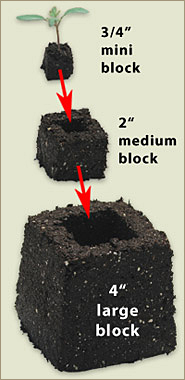
With a soil-blocking system, the process of potting on involves starting seeds in small blocks, then transplanting the growing seedlings into successively bigger blocks.


